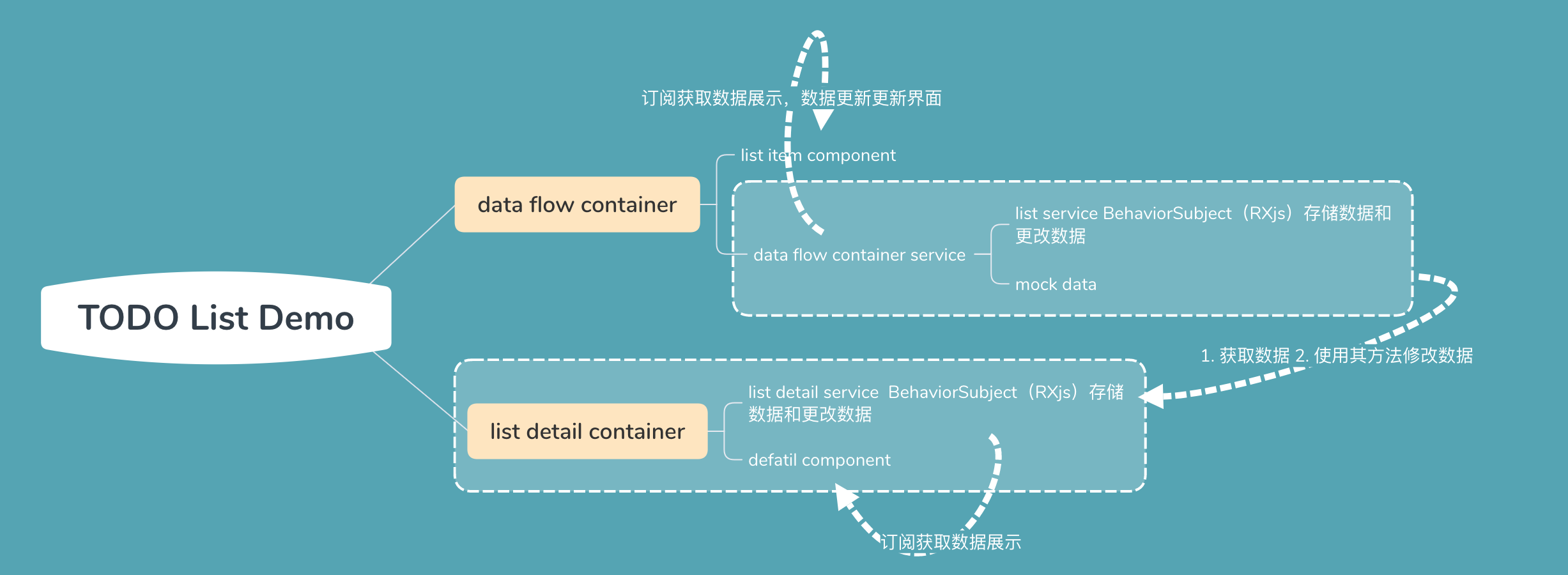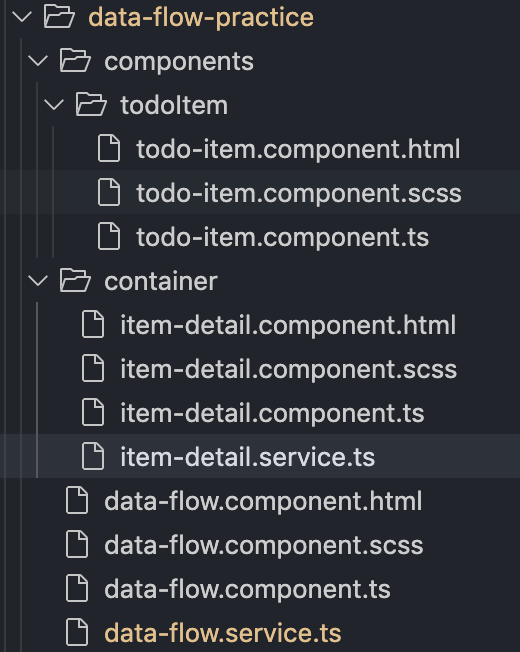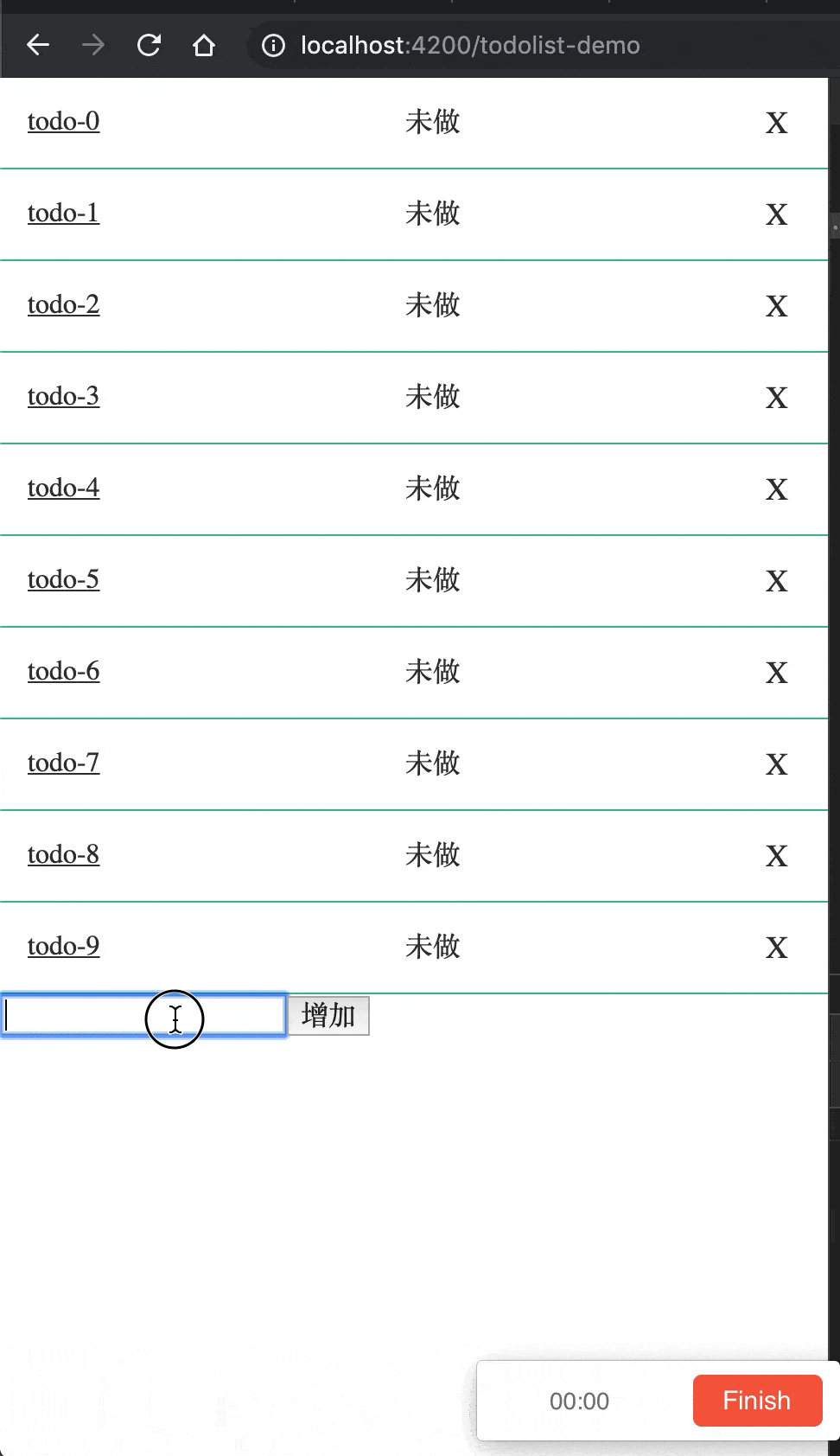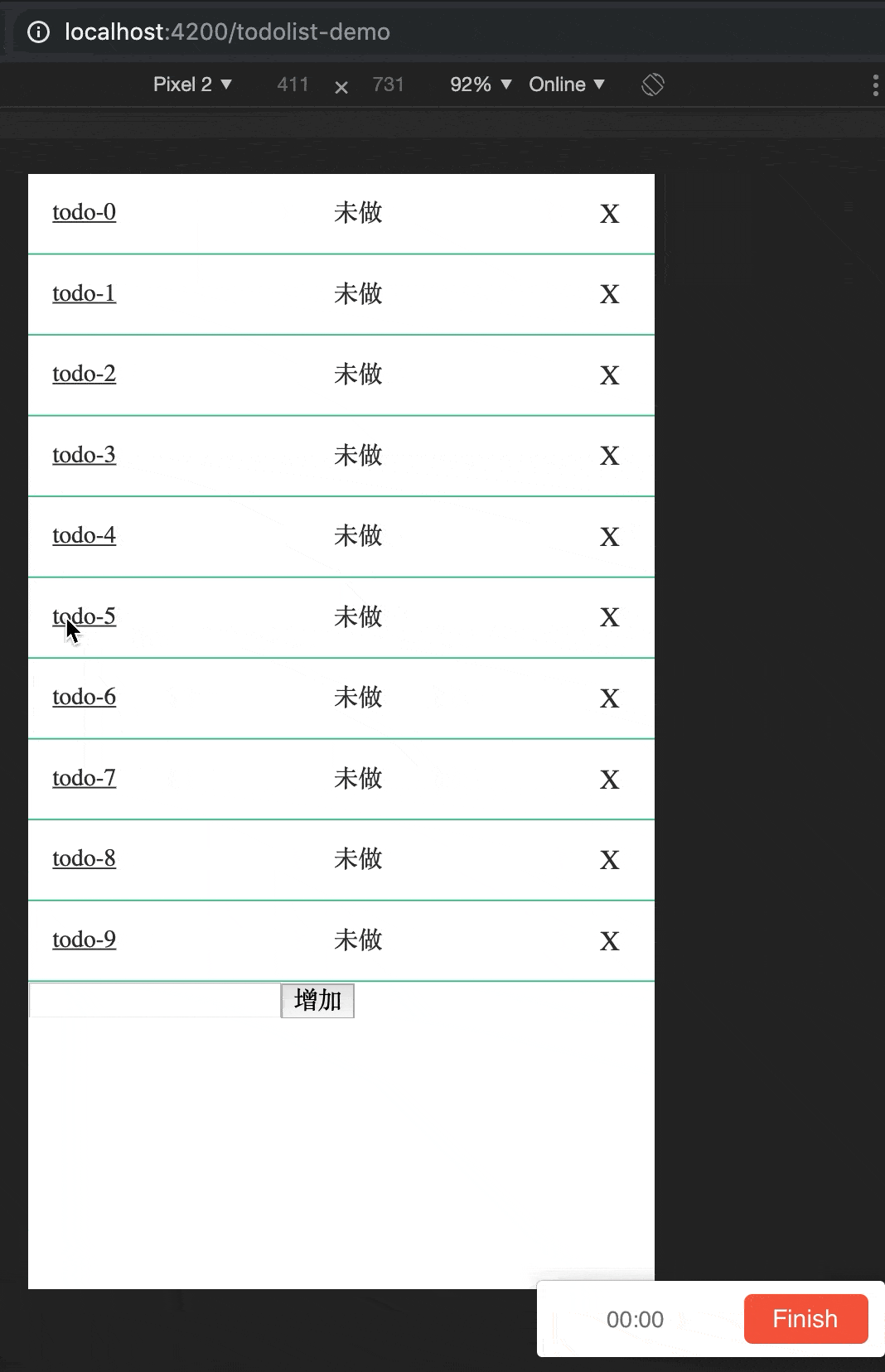Angular + rxJS 的数据流向实例与讲解
作者:markzzw 时间:2019-12-24 本文代码: github
简介
通过 todo list 例子简单展示一个 Angular 中的数据流管理方案;如图:

项目结构如图:

我们的目的很简单:
- 生成若干
TODO item; - 展示这些
TODO item; - 修改
TODO item,使其数据能够进行同步,而不需要进行数据重新请求;
data-flow.componnet.ts & data-flow.service.ts
从最外层组件开始,我们会有一个 container 作为入口,并且会配备一个 service 作为其数据管理层
- data-flow.service.ts
...
@Injectable({
providedIn: 'root'
})
export class DataFlowService {
dataFlowSubject: BehaviorSubject<DataFlowData>;
dataFolwData: DataFlowData;
constructor() {
if (!this.dataFolwData) {
this.dataFolwData = this.initDataFlowData();
this.mockList(10);
}
this.dataFlowSubject = new BehaviorSubject<DataFlowData>(this.dataFolwData);
}
getDataFlowSubject = () => {
this.updateData();
return this.dataFlowSubject;
}
initDataFlowData = () => ({
list: []
});
updateData = () => {
this.dataFlowSubject.next(this.dataFolwData);
}
mockList = (num: number) => {
const list: TodoList[] = [];
if (num > 0) {
for (let i = 0; i < num; i++) {
list.push({
id: cuid(),
text: `todo-${i}`,
status: TodoStatus.TODO
});
}
}
this.dataFolwData.list = list;
}
...
}
data-flow.componnet.ts
@Component({ selector: 'data-flow', templateUrl: './data-flow.component.html', styleUrls: ['./data-flow.component.scss'] }) export class DataFlowComponent implements OnInit { dataFlowSubject: BehaviorSubject<DataFlowData>; todoList: TodoList[]; constructor( private dataFlowService: DataFlowService ) { this.dataFlowSubject = this.dataFlowService.getDataFlowSubject(); } ngOnInit() { this.dataFlowSubject.subscribe((data: DataFlowData) => { this.todoList = data.list; }); } }
我们将 service 注册在 root,使其成为一个当 app 生成就存在的单例,并且初始化数据,mock 假数据,使用 rxJS 生成一个 BehaviorSubject 的订阅器,然后将初始化的数据,放入生成的订阅器作为初始数据;
再在构造 component 的时候获取到 service 中的订阅器,在组件初始化的钩子函数中订阅上我们的更新方法,这样 component 与 service 就建立了联系;
这里不难看出,我们在 service 中存储了一个持久化的数据,也就是我们的总的一个数据,我们后面就只会修改这个数据,然后再进行重绘进行组件的更新,虽然这里的数据是 mock 的假数据,但是在真实项目中,我们也可以将取回来的数据存在这里,然后对其做 增 删 改 查 的操作,这样子可以避免一些不必要的网络消耗,但是也会存在一定的弊端,就是数据量不能建议太大;
所以接下来我们给其增加上 add 函数来增加 TODO,
data-flow.service.ts
add = (item: TodoList) => { this.dataFolwData.list.push(item); this.updateData(); }data-flow.componnet.ts
addTodo = () => { if (this.addText) { this.dataFlowService.add({ id: cuid(), text: this.addText, status: TodoStatus.TODO }); this.addText = ''; } }
由于我们在 service 的 add 中使用了 updateData 触发订阅器的 next,将最新的数据传出,component 就会接收到数据就会根据数据进行重绘;

同理,我们也可以写上删除的方法,也是调用 updateData 触发订阅器更新数据,
todo-item.component.ts
@Component({ selector: 'todo-item', templateUrl: './todo-item.component.html', styleUrls: ['./todo-item.component.scss'] }) export class TodoItemComponent implements OnInit { @Input() todoItem: TodoList; constructor( private dtService: DataFlowService ) { } ngOnInit() {} deleteItem = () => { this.dtService.deleteItem(this.todoId); } }data-flow.service.ts
deleteItem = (id: string) => { this.dataFolwData.list = this.dataFolwData.list.filter((item: TodoList) => item.id !== id); this.updateData(); }

detail.component 和 data-flow.service 的关系
为了更明显的验证 data-flow service 的数据是持久化的,并且能够重复使用的,新建一个组件 detail container 展示详情数据以及可以更改数据,然后将数据同步到 data-flow service ,再次回到 data-flow container ,查看我们的修改是否生效;
detail.component
@Component({ selector: 'item-detail', templateUrl: './item-detail.component.html', styleUrls: ['./item-detail.component.scss'] }) export class TodoDetailComponent implements OnInit { detailSubject$: DetailServiceSubject; detailId: string; detail: TodoList; isLoading: boolean; todoStatus = TodoStatus; constructor( private route: ActivatedRoute, private router: Router, private detailService: DetailService, private dataFlowService: DataFlowService ) { this.detailSubject$ = this.detailService.getDetailSubject(); this.detailSubject$.subscribe(this.updateDetail); } ngOnInit() { const newId = this.route.snapshot.paramMap.get('id'); this.isLoading = true; if (newId === this.detailId) { this.isLoading = false; } else { this.detailId = newId; this.detailService.getDetail(this.detailId); } } get status() { return statusMapping[this.detail.status] || '无状态'; } updateDetail = (data: TodoList) => { this.detail = data; this.isLoading = false; } changeValue = (event: Event) => { const value = (event.target as HTMLInputElement).value; this.detail.text = value; } delete = () => { this.dataFlowService.delete(this.detailId); this.router.navigate(['/todolist-demo']); } change = () => { this.dataFlowService.updateItem(this.detail); this.router.navigate(['/todolist-demo']); } changeStatus = (event: Event) => { const value = (event.target as HTMLInputElement).value; this.detail.status = value as TodoStatus; } }detail.service
@Injectable({ providedIn: 'root' }) export class DetailService { detailSubject: DetailServiceSubject; detailData: TodoList; constructor( private dataFlowService: DataFlowService ) { this.detailData = null; this.detailSubject = new BehaviorSubject<TodoList>(this.detailData); } getDetailSubject = () => { this.updateData(); return this.detailSubject; }; getDetail = (id: string) => { if (get(this.detailData, 'id', null) === id) { this.updateData(); } else { this.dataFlowService.asyncGetItemById(id, (data: TodoList) => { this.detailData = data; this.updateData(); }) } }; updateData = () => { this.detailSubject.next(this.detailData); } }data-flow.service.ts
updateItem = (item: TodoList) => { this.dataFolwData.list = this.dataFolwData.list.map(todo => { if (todo.id === item.id) return item; return todo; }) } asyncGetItemById = (id: string, callback) => { const detail = this.dataFolwData.list.filter(item => item.id === id)[0]; setTimeout(function() { callback(detail) }, 1000); }; changeStatus = (item: TodoList) => { this.dataFolwData.list = this.dataFolwData.list.map((d: TodoList) => { if (d.id === item.id) { return item; } return d; }); this.updateData(); }
同样的,container 层面的 component,都将数据放在 service 中进行处理和更新,detail component 也使用这样的方式,进行数据的订阅和更新;
在 detail component 中,声明了 dataFlowService,是为了将数据的更改同步到列表页面的数据中去,这样子在回到刚才那个页面的时候,数据才会得到更改,当然这里只是同步必要的数据,比如 状态 文字 删除,如果有其他的数据仅仅只是 detail 独有的,但是不是 list 拥有的数据,就不需要同步;
效果如图所示:

在进入 detail 页面时,会有一个 loading 的提示,这是制作的一个假的异步获取的代码,在 detail component 中有一个判断,如果当前的 id 与 前一个 id 不相同则进行请求数据,相同就直接取消掉 loading 效果,这是因为,在构造这个组件的时候,用的是 BehaviorSubject,这个订阅器在订阅的时候会将最后一次数据传过来作为数据使用,所以当 id 相同时在 detail component 中,不再需要去进行获取数据的操作,这也就减少了一些网络请求,增加了用户体验;
总结
通过service进行数据管理,在component中订阅数据更新方法,获取到(新)数据进行页面更新,进而减少对网络的请求,提升用户体验,也能够有一个较为清晰的数据流向,能够容易的理解数据流向就能够容易理解业务上的流程;